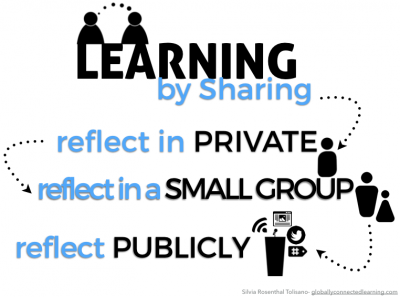Amplify Reflection

Reflection is an important component of the learning process. It can NOT be seen as an add-on, something to be cut if time is running short. We have all heard John Dewey’s quote:
“We don’t learn from experience, we learn from reflecting on the experience”
Reflection also takes on an important role in documenting learning, blogging as pedagogy and formative assessment. Asking a teacher to simply “reflect” on a lesson taught or asking students to “reflect” on their learning, will often be met with blank stares. Being able to reflect is a skill to be learned, a habit to develop. Reflection requires metacognition (thinking about your thinking), articulation of that thinking and the ability to make connections (past, present, future, outliers, relevant information, etc.).

In addition to inherent components of reflection, which traditionally have been viewed as internal (thinking about one’s own learning and that thinking primarily benefiting ourselves), we need to take a closer look at amplifying reflection by sharing our reflection transparently (learning how to articulate and make our thinking visible to others and the learning benefiting ourselves AND others). By sharing our reflection beyond a teacher or a classmate, we acknowledge our voice as learners and the role that it can play in the learning process (our own process or the one of others).

Here are a few routines, taxonomies, and prompts that support reflection in ourselves and give a variety of choices to grow as reflective, metacognitive learners.

Routines
Visible Thinking Routines by Project Zero
Download an ebook with all the routines
KWHLAQ
(interested in learning more about the KWHLAQ upgrade?)
Tools and ideas to transform education. Sign up below.


Taxonomies
Reflective Teacher by Peter Pappas

Bloom’s Remembering – Reflection: What did I do?
Bloom’s Understanding – Reflection: What was important about what I did? Did I meet my goals?
Bloom’s Applying – Reflection: When did I do this before? Where could I use this again?
Bloom’s Analyzing – Reflection: Do I see any patterns or relationships in what I did?
Bloom’s Evaluating – Reflection: How well did I do? What worked? What do I need to improve?
Bloom’s Creating – Reflection: What should I do next? What’s my plan / design?
SOLO Taxonomy by John Biggs and Kevin Collis
“SOLO, which stands for the Structure of the Observed Learning Outcome, is a means of classifying learning outcomes in terms of their complexity, enabling us to assess students’ work in terms of its quality not of how many bits of this and of that they got right.“
There are five stages
- Prestructural – incompetence (they miss the point).
- Unistructural – one relevant aspect
- Multistructural – several relevant and independent aspects
- Relational – integrated into a structure
- Extended Abstract – generalized to new domain
These stages can be looked at through the lens of reflection purpose:

Keywords & Prompts
Four Dimensions of Reflective Learning by Karen Barnstable . Also look at 40 Reflection question to help you look back, forward, inward and outward by Edutopia.
- I. Thinking Back
- II. Thinking Forward
- III. Thinking Inward
- IV. Thinking Outward
- What?Describe the experience; outline what happened that compelled you to think about and change your behavior (i.e. learn).
- So What?Describe what difference it makes; outline what impact or meaning it has for you (or why it should matter to others).
- Now What?Describe what’s in store for the future now that you’ve learned from this experience; outline what you are going to will do to continue learning.
Higher Level Question Stems from Bloom’s Taxonomy by Professor Julie Hall
Create:
Can you create new and unusual uses for____?
Can you design a____to____?
Evaluate:
Do you agree with____?
Prioritize____
How would you decide about____?
Analyze:
Classify____according to____.
What solutions would you suggest for____?
Outline/diagram____.

Tell Me More by Paul Solarz in his book “Learn like a Pirate”
- 1st Sentence answers a question
- 2nd sentence responds to “tell more more”.
Paul Solarz’Generic Reflection prompt
- Step 1- Describe what happened or what you did in the lesson
- Step 2- Interpret how things went by using one or more of these sets of themes: strengths and weaknesses, successes and setbacks
- Step 3- What have you learned due to the experience?
- Step 4- Answer one (or more) of these questions: What can you do to improve your learning? How will you extend your learning past what is expected?

Dr. Jackie Gerstein’sreflection questions:
- What was your significant learning this past week( days) ?
- What principles for everyday life can you extract from our class activities?
- What did you learn or what was reinforced about yourself?
- What can you take from the class activities to use in your life outside of class?
Ann Davis :Reflection questions for elementary school students
- What did you learn?
- How do you know you learned it?
- What got in the way of your learning?
- What helped your learning?
- How did you feel?
cross posted at langwitches.org/blog
Silvia Tolisano is a Curriculum21 faculty member, author of the book Digital Storytelling Tools for Educators and founder of the Around the World with 80 Schools project. Read more at http://langwitches.org/blog.
